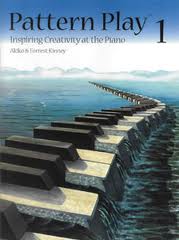 Are you familiar with Forrest Kinney’s series “Pattern Play”? If you’re like me, you’ve seen the ads in American Music Teachers, seen the books at convention, and maybe attending a publishers showcase given by Forrest Kinney. I had seen these books around, but never really known what they were or how they worked.
Are you familiar with Forrest Kinney’s series “Pattern Play”? If you’re like me, you’ve seen the ads in American Music Teachers, seen the books at convention, and maybe attending a publishers showcase given by Forrest Kinney. I had seen these books around, but never really known what they were or how they worked.
I learned some more about them at the MTNA 2013 convention, and ordered the first two books for myself. There are six books total in the series. I am so excited to start using these! Each book has a series of patterns to use as a basis for improvisation. These include a solo version, duet version, and sometimes a trio or quartet version. Each piece included has a “pattern” and a “vacation” section. Basically, and A section and a contrasting B section. They are really simple to play, but sound great! When I got my two books in the mail, I sat down at the piano to start playing through them. Now, you remember that I have very minimal improvisation skills? My husband walked in and said “so, you’re just improvising that?” with a slight sense of amazement. He’s primarily a vocalist and guitarist, but met the piano proficiency requirements in college, so he wanted to join in on the fun! In just a few minutes we were able to play through several of the duet versions together.
So, how can you use these with your students? There are several great ways to incorporate these books. Your students don’t need a copy of the book, all you need is a teacher copy to use them. The simplest thing is to use the duet version to incorporate a little improvisation into a private lesson. The bass part is typically a little more complex, so you the teacher could play that, while your student improvises a melody using the parameters given. You could also use these in group classes, especially the ones with a quartet version. I am planning a summer ensemble and improvisation camp that will use the Pattern Play books as a basis for our group improvisations. You can use the quartet version and then add some extra rhythm instruments, or double parts, depending on how many students you have. I also saw a presentation on RMM classes that used Pattern Play for adult classes. Because the pieces sound really nice and full, they are great for adults with minimal playing and reading skills who still want to feel like they are creating great music.
Have you used the Pattern Play books? What ways have you found are most effective for using them?
Author: Spring
Spring Seals, NCTM, teaches 60 piano students ranging from age 3 to 70 in Fort Worth, Texas. She also serves as the Director of Certification for TMTA. She is passionate about helping teachers become more effective in their studios through professional development, new resources, and fresh ideas.

Love this post – thank you for sharing! I’m ready to order them right away for summer camp and fun summer lessons. I had one question – what’s the leveling of the books? How many are appropriate for elementary students and how many for intermediate students?
I can’t speak for the whole series, I haven’t looked at the last 4 books in enough detail, but the first two I have would be appropriate for both elementary and intermediate students. They are very flexible, so you could simply tell the student “play only black keys” or “play these white keys only” while you play the accompaniment, or you could give the student a more complicated part from the same piece. I am assuming they get more difficult in the later books and don’t allow for as much use with elementary students, but I don’t know for sure.
I haven’t used these yet, but I’ll definitely look into this; I’ve been hearing a bit about these recently. Thanks for sharing! 🙂